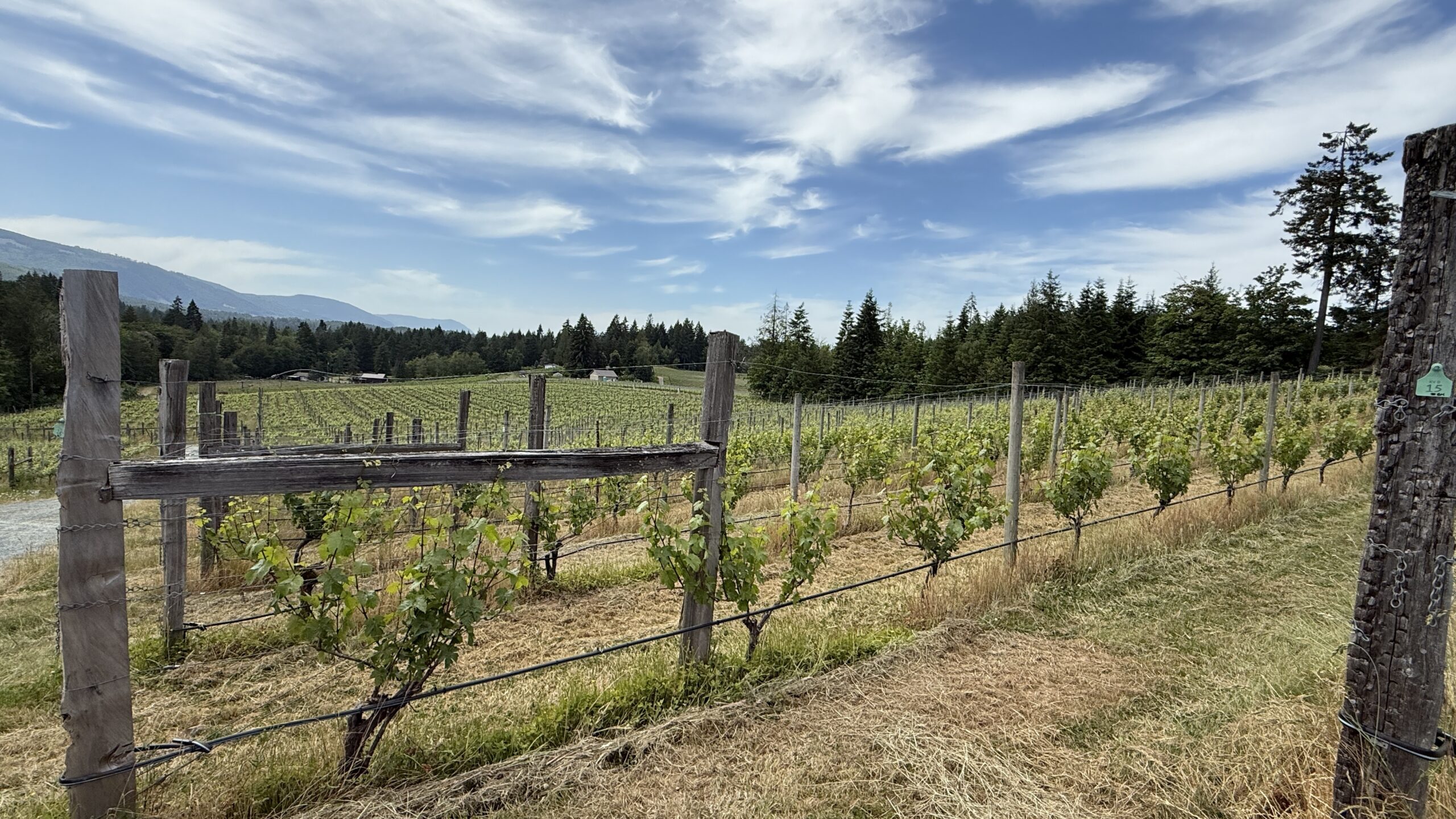Not heard of Cowichan Valley on Vancouver Island, British Columbia, Canada? You may thank me for bringing this region to your wine traveling attention. This article is about what to expect when you visit today, and why I think the future is bright for this region.
History and Geology
Cowichan Valley is on the traditional lands of the Cowichan Tribes and Coast Salish Peoples, and when you catch your first glimpse of the lake you can easily imagine how fishing, hunting and growing sustained them. Today, the greatest concentration of wineries is located here given the unique microclimates and soil types that allow for exceptional winemaking.
I asked Stacy Hornemann, winemaker at Blue Grouse to describe the geology and growing history. “Cowichan Valley on Vancouver Island is a wild place to grow wine. The Island’s terrain has been shaped by a mixture of upwelling of seabed, volcanic activity, seismic activity, and impact from glacial evolution. Commercial winegrowing is a relatively recent industry in the Cowichan Valley with fruit and berry wines being produced since the 1920s, but commercial wineries didn’t arrive until the 1980s.”
Island Charm and Charme L’ile
Let’s talk Hybrids, Crosses and Vitis Vinifera. Over 150 varieties of grapes were planted as part of an experiment – at the current locations of both Blue Grouse and Zanatta wineries – between 1981 and 1986 (See Blue Grouse history for details). This was part of a provincial government experiment to stimulate the wine industry. This diversity of grapes resulted in several prominent hybrids (Vitis Vinifera and other species), and “crosses” (Vinifera grapes crossed) such as Cabernet Sauvignon and Sangiovese. This is fairly uncommon on the west coast of North America, and is part of the “Island Charm” of Vancouver Island.
“Charme de L’ile” (French translation “Island Charm”) is a double entendre specific to the Cowichan Valley G.I. It refers not only to the Island, but to the Charmat method of producing sparkling wine in tanks (think Italian prosecco or German Sect). Get it? Charmat – Charming.
85% of British Columbia vineyard acreage and a majority of the wineries (200+ licensed) lie within the Okanagan Valley G.I. (Geographic Indication). There were a total of six G.I.s in the Okanagan Valley. As of 2020, Cowichan Valley was approved as the first “Island” sub-G.I. in Okanagan Valley, with only 13 wineries and some exciting growth planned.
I asked Kenzie Knight of Tourism Cowichan what’s special about the region’s wine country. “Wine’s a big part of why people are sticking around Cowichan. The climate and soil make for standout bottles, and the small, family-run wineries give visitors something real — not just a tasting, but a sense of place. It’s not polished or packaged. It’s authentic, and people are picking up on that.” Well said, Kenzie.
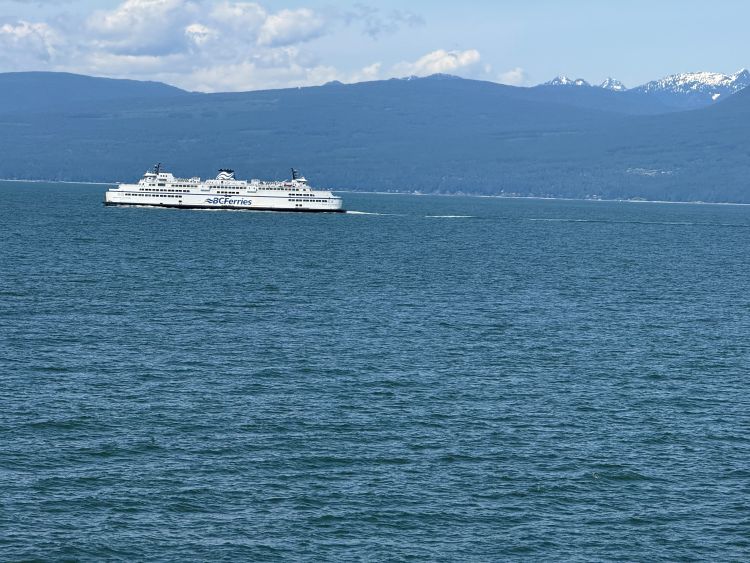
Getting There and Away
The proximity to both Vancouver and Victoria, BC makes for easy access and a potential urban-country experience. Here’s what you need to know. Click here to view the Cowichan Valley Wine Trail and Map.
We loved the drive to the ferry to Vancouver Island and Cowichan Valley. You can check schedules for multiple crossings at BCFerries. There are many options for international visitors and arrivals from the U.S.
- We arrived from Portland, Oregon to Port Angeles in under 5 hours, and took the Black Ball Ferry to Victoria, the Provincial Capital of British Columbia. It’s a pleasant two-hour ferry ride across the Salish Sea. It was an easy two-night stay in Victoria before heading north to wine country.
- The drive from Seattle is estimated at three hours.
- Drive to Vancouver, B.C., an international city and the largest in Western Canada. Depart on car ferry from Vancouver at Horseshoe Bay, arrive at Departure Bay in Nanaimo.
- Fly into Victoria (YYJ) – check airline departures from your home city
- Fly into Nanaimo (YCD) – great option for Eastern Canadians
Duncan is in the heart of Cowichan and is about one hour north of Victoria. The main growing areas include Cobble Hill, Cowichan Bay, Duncan, Glenora, Mill Bay, and North Cowichan. The general area centers around Cowichan River, Cowichan Bay and Cowichan Lake. Check out these sites to plan your own wine adventure https://www.tourismcowichan.com/, and https://www.cowichanwineries.com/.
Note: You will need your U.S. passport to enter Canada, although we heard that Real-ID U.S. driver’s licenses are or will be accepted in the future. If you have your own car, there’s no excuse for not purchasing wine during your trip. Bring Canadian wine home to the U.S. Two cases are widely considered acceptable for personal consumption. Pay minor duties and taxes amounting to about $1 U.S./bottle.
Suggested Itinerary – Where to Tour, Taste, Stay and Play
I was able to visit 9 of the 13 wineries in the valley. Here’s what I liked and what I’d recommend for a 2–3-day wine tour excursion. All are family-owned and operated, except for Blue Grouse and Unsworth, which are also small operations, now owned by members of Jackson Family Wine Group of California. This is a good sign in my opinion, as the Jackson Family has shown extraordinary care in curating the brands and properties in their portfolio. Their experience and reach should be a plus for the region.
The visit order can be flexible based on where you’re staying, whether you want lunch mid-tour – dine at Unsworth or area eateries – or if you’re looking for specific varietals or wine experiences.
Enrico Winery
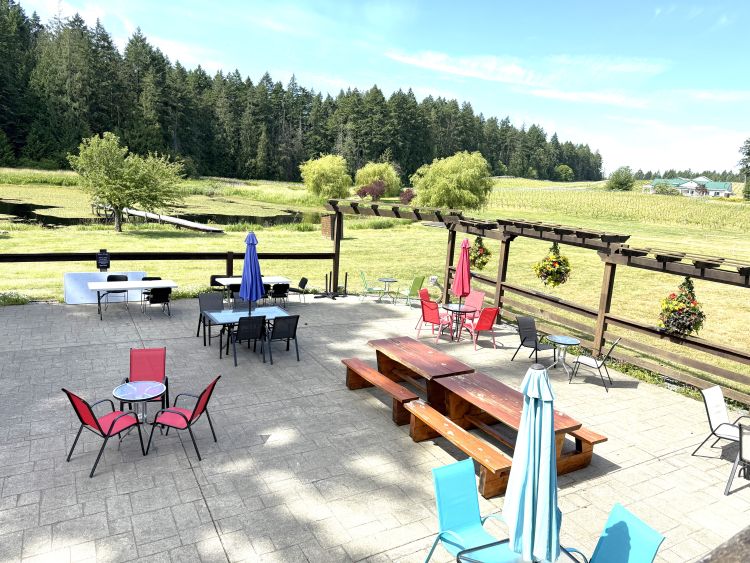
Enrico Winery was the first stop on our tour, and an eye-opener. GM Lorin Inglis turned this sleepy winery into a local’s favorite by focusing on how to be unique and offer what he believes the Island does best – Hybrids. Lorin leans into the Island’s climate —cool, unpredictable weather—and chooses to grow and champion disease-resistant hybrid varieties. These are not your typical BC wines, and that’s the point. The wines are approachable, experimental, and quite drinkable.
I asked Lorin to share his thoughts on Hybrids. “The distinction that is created by having “new varietals” in the form of Hybrids will always be a bit challenging, but I think the benefits will out way the negatives. It will always be a bit more work to explain the finished product to customers. These cool climate disease-resistant grapes create an advantage for the grower and a talking point to the consumer.”
What’s on Offer
The tasting room is open Wed-Sunday 12-5pm. $15 gets you 6-7 wine tastes. Snacks, charcuterie boards, and flat breads are available, and you can BYO picnic. Bottles and cans are in demand. There are also five units of lodging on the. Live music happens on the weekend. Fun place to stay and play?
Author’s Wine Pick – The Tempest (Ortega). White Wine.
Blue Grouse
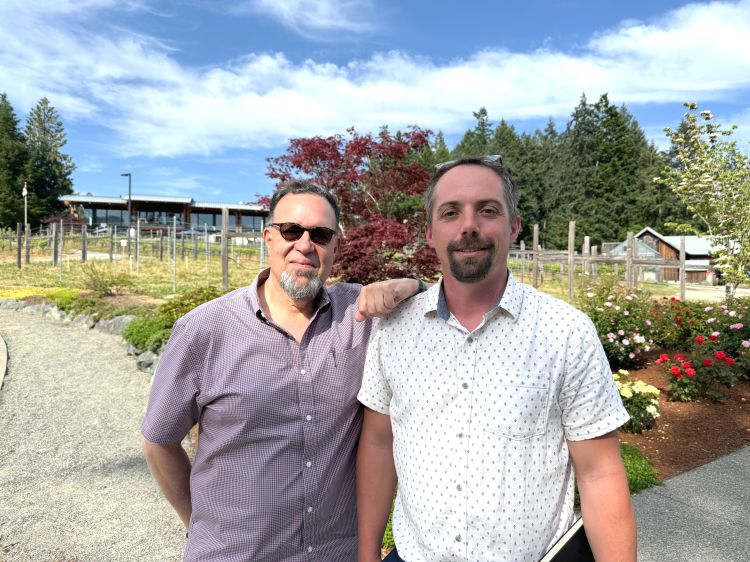
Blue Grouse is the second licensed winery on the island and opened its doors in 1992. Today, Blue Grouse is a modern, elegant destination with strong ties to the valley’s agricultural roots. Blue Grouse maintains about 1 acre of the original hybrid plantings in the early 1980s, and farms them sustainably – rainwater capture, irrigation ponds, geo-heated and cooled buildings – along with the classic international varieties like Chardonnay and Pinot Noir. I’m expecting big things from the management team led by GM Michael Abbott, and California winemaker Stacy Hornemann. Stacy came along with the 2022 acquisition of Blue Grouse by Jackson Family Wines of California. This should be a long-term and reliable class act. Blue Grouse is also a founding member of SWGBC (Sustainable Wine Growers of BC).
What’s on Offer
Tastings can be casual or customized; staff is knowledgeable without being overbearing.
The tasting room is open daily from 11am – 5pm. Appointments are preferred and suggested, although walk-ins are welcome based on staffing and capacity. There are multiple experiences available so check the website for options. Charcuterie, pizza and BYO picnic are encouraged. $15 for five wine tastings. Check the website for special events. Contact the tasting room for “Grouse House” lodging availability.
Author’s Wine Pick – Cowichan Valley Ortega. White Wine.
Meet Blue Grouse Winemaker Stacy Hornemann
Venturi-Schulze
Venturi-Schulze is a longtime island winery doing things its own way. The Schulze family is deeply rooted in traditional European winemaking and owns one of the few estate balsamic vinegar operations in Canada. Giordano Venturi and Marilyn Schulze purchased the property in 1987, and their daughter, the charming and outspoken Michelle Willcox Schulze runs the entire operation today. You’ll likely meet her if you visit. Be sure to ask for a tour of the Balsamic production room. You’ve never seen anything like it.
What’s on Offer
Contact daughter Michelle for visits. She’s running the operations and is running the tasting room and runs all operations. Appointment details here https://www.venturischulze.com/visit.
Author’s Wine Pick – “From the Before Time” Pinot Noir
Meet Venturi-Schulze Winegrower Michelle Willcock Schulze
Cherry Point Estate

Cherry Point Estate was purchased by the Xavier Bonilla family in 1990. The seaside property is 34 acres with 22 under vine. They grow a total of 14 different varieties, a legacy of the early 1980s BC Provincial hybrid grapes project. You can feel the ocean breeze, such is the proximity of the estate vineyards to the Saanish Sea. The wines show bright acidity and some pleasant salinity.
Today, Chery Point is known for weddings and events, but it’s also a solid winery to visit for bold, lesser-known whites. Siegerrebe is their flagship, and their older vines make impressive wines of character.
What’s on Offer
The tasting room is open daily 10am-5pm, and appointments are suggested. Weddings and events are a mainstay for the winery. I’ve heard the annual Paella event is not to be missed. Inquire directly online or in person for appointments, times and details.
Author’s Wine Pick – Old Vines Siegerrebe
Unsworth Vineyards
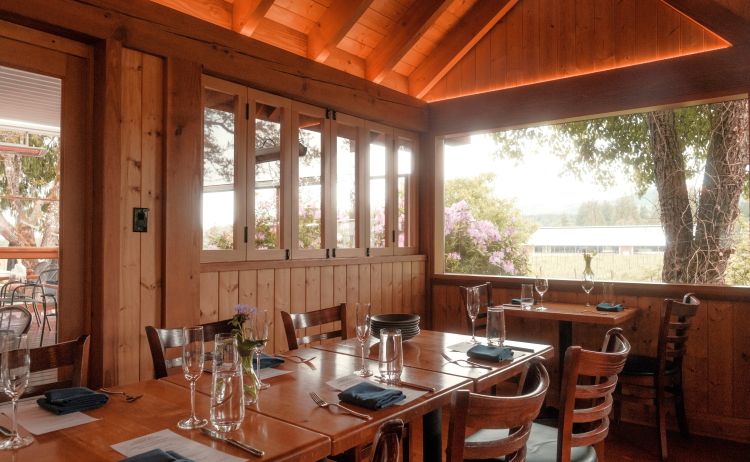
Unsworth Vineyards is arguably the region’s best-known winery. According to Chris Turyk, son of founders Tim and Collen Turyk, Unsworth is planning ambitious production growth and consumer facilities. They currently have a total of 50 acres under vine in the valley. As new plantings mature, they expect production to grow to 50K cases over the next several years. All of this under the purview of their new owners and patrons – Jackson Family Wines – a positive development for the region, in my opinion.
It’s a great place to stop for a longer lunch or to dig into structured tastings. We had lunch with Chris who calls Cowichan Valley “Canada’s Provence”. I’ve been to Provence several times, and while this may be a stretch (all respect to you, Chris), the region does have the highest year-round temps in Canada.
The Restaurant at Unsworth is also expanding. It’s the place to have an extended winery lunch and tasting. The Cowichan Valley Pinot Noir is both the best-seller and for good reason.
What’s on Offer
The tasting room is open daily 11am-6pm, and there are a variety of different tasting options to consider. Appointments are recommended. Picnics are permitted. Check the website for seasonal hours at the restaurant. You’ll need a reservation during summer hours, which include lunch and dinner daily.
The one wine most emblematic of the brand – Cowichan Valley Pinot Noir
Author’s Wine Pick – Cowichan Valley Pinot Noir
Meet Unsworth Winemaker Dan Wright
Zanatta Estate Winery
Zanatta Estate Winery is the original commercial winery on Vancouver Island, effectively the “First Family of Vancouver Island Wines”, established in 1992 when small growers were permitted to operate estate wineries. They are credited with originating sparkling wine on the Island.
The Zanatta family’s heritage as sparkling wine pioneers continues, although you’ll find plenty of still wines to taste. Dennis Zanatta came to Canada from Treviso in the Valdobiaddene region of Italy, known for its prosecco sparkling wines. His daughter Loretta Zanatta and winemaker-husband (or husband-winemaker) Jim Moody continue the bubbly tradition.
One of the 25 acres of vineyard land on today’s site was used by the Provincial government for its early 1980s hybrid testing, and some of the original vines remain today. The “Duncan Project” is a hallmark of the testing that occurred on Vancouver Island to identify winegrapes most resistant to disease and suited for the climate.
What’s on Offer
The farmhouse tasting room is open Wednesday to Sunday 11-5pm.
Author’s Wine Pick – Damasco white blend
Meet Zanatta Estate Winemaker Jim Moody
Alderlea Vineyards

Alderlea Vineyards is one of Cowichan’s top-rate producers. The estate-grown Pinot Gris and Bacchus are worth seeking out. You’ll also find an interesting high-acid, floral Sauvignon Blanc, and Marechal Foch hybrid wines. Alderlea Vineyards was the fourth vineyard planted on the island in 1993. It was acquired by Julie and Zachary Powell in 2017. Zac has international winemaking experience, including several vintages in Czechoslovakia. Julie heads up Cowichan Wineries Society, the marketing arm for area producers. This is a great stop to get perspective on “Island Wine” history and project future.
What’s on Offer
The tasting room is open by appointment only. Call 250-746-7122 or email alderleavineyards@shaw.ca. Tastings are personal and low-key. Wife and husband dynamic duo – Julie and Zac will take good care of you and your group.
Author’s Wine Pick – Pinot Gris
Meet Alderlea Winemaker Zac Powell
Emandare
Emandare Vineyard is a farm-first, family-run winery. Owners Mike and Robin Nierychlo are deeply involved in the day-to-day, and it shows in the authenticity of their tasting experiences. Pinot Noir is their pride and joy. Tastings include a vineyard tour and are refreshingly uncommercial.
What’s on Offer
The tasting room is only open on Saturdays from 12-4pm, so that Robin and Mike can have a family life on the farm. Each visitor to the tasting room enjoys a by-appointment-only 90-minute vineyard tour and tasting directly with winemaker Mike. Each tasting includes wines and a local cheese and charcuterie plate for $45, waived with the purchase of a case or wine club membership. Check the website for details.
There is also a charming guest house available for rent. This would be a low-key base of operations for families or couples that want to dive deep into the area.
Author’s Wine Pick – Pinot Noir
Averill Creek
Averill Creek is perhaps the most polished and ambitious of the Cowichan wineries. Andy Johnson and Averill Creek were drivers in bringing recognition to Cowichan, and a visit here is a must when planning your next trip. Andy Johnson helped put the region on the map with premium-tier Pinot Noir and a modern, serious tasting room.
Andy put a stake in the ground and trellis on the hill in 2001 and made a statement that Vitis Vinifera (specifically Chardonnay and Pinot Noir) was what Vancouver Island should be known for. There are currently 30 acres under vine, only 10 miles from the coast, so perfect for cooling vineyards and retaining acids.
Winemaker Brent Rowland joined Andy in 2018 with much international experience. He’s known for 100% whole cluster and wild fermentations (no commercial yeast), and not fining or filtering his wines. He explained that adding whole grape clusters to the fermentation bins adds potassium and lowers pH enhancing acidity with perfume or floral characteristics of the fruit. See his interview below.
What’s on Offer
Tasting room is open daily 11am – 5pm by appointment. Walk-ins are welcome.
You’ll find a variety of food offerings, from tinned fish and charcuterie to duck pate. Don’t miss their substantial cheese and olive plate, tinned fish and chips and duck pate plates.
Author’s Wine Pick – Somenos Pinot Noir
Meet Averill Creek Winemaker Brent Rowland
Where to Stay
- Best Western Cowichan Valley (Duncan)
- Oceanfront Suites at Cowichan Bay
- Moon Water Lodge (off Malahat Highway)
- Dream Weaver Lodge (Cowichan Bay)
- Shirley’s Cozy Nest (Mill Bay)
- Crown House B&B (Lake Cowichan)
Dining in Style

If fresh seafood is your thing, you will not be disappointed. There’s also a focus on farm-to-table dining, with lots of organic produce and artisanal cheeses and meats available. Seafood was our meal of choice for lunch and dinner daily. Fresh Pacific salmon, Dungeness crab, halibut, mussels, clams, you name it.
- Bridgemans Bistro
- Unsworth Vineyards
- The Cook and Butcher (Cowichan Bay)
- Shipyard Restaurant & Pub
- Genoa Bay Cafe
- The Masthead Restaurant
What to Do – Where to Play
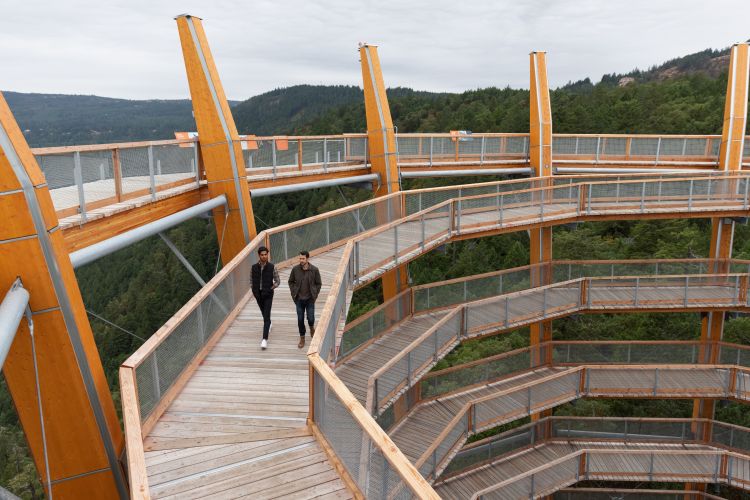
Malahat Skywalk – known for accommodating everything, from Strollers to Wheelchairs
Malahut Skywalk, which opened in 2021, was designed as an accessible attraction available to everyone – whether in strollers or wheelchairs – on the ancestral lands of the Malahut Nation, which is one of several tribes of the Coast Salish People. The owners of the Skywalk share a portion of revenues with the 350-member nation.
We arrived from Victoria in about 35 minutes, just prior to opening. The site is open daily https://malahatskywalk.com/ and gets about 300K visitors per year. My advice is to arrive in the mornings (ideally around 8:50am) mid-week, or early on weekends, which is a great strategy for those who want the quiet majesty to themselves, at least for a short while.
The 10-story structure towers above the old-growth forest with a 360-degree mountain and island views. The Saanich Inlet is a glacial fjord leading to the Saanich Sea and ultimately the Pacific Island. Your view over all this is shared only with other visitors, red-tailed hawks and one of the largest populations of bald eagles in the world. You can choose to round-trip the elevated walkway or dive into the chute slide to the bottom. Kids choose the latter option. The current record for the number of slides in one day is 50.
- The Raptor Center in Duncan – Flying demos and literally “hand on” experiences
- Cowichan Bay Road – A charming detour with oceanfront scenery and small-town shops.
- Glenora Road & Vaux Road Loop – a bucolic drive through rolling farmland and vineyards, and connects several key wineries.
- Cowichan Wine Festival – https://www.cowichanwineries.com/
- Outdoor Activities
Hiking and Biking, Golf, water activities include kayaking, paddleboarding and SUPing, whale watching. Arts and culture – galleries, music festivals, etc. Farmstands for fresh produce.
- Route of the Totems – Running the length of the east coast of Vancouver Island – from Victoria to Port Hardy – you find 19 totem poles, carved by British Columbia First Nations artists as part of an effort to connect the island to mainland B.C. The City of Duncan (also the heart of Cowichan wine country) worked closely with the Cowichan tribes to restore and maintain the totems, and is called the “City of Totems”. Interpretive signs give the backstory on the artists and history of the artwork. Check the Duncan website: http://www.duncansightseeing.com/provincial-route-of-the-totems-salish-bear/
Carl Giavanti is a recovering winery publicist with a passion for people and storytelling. After 15 years of PR consulting, wine business writing, and interviewing wine writers, Carl is laser focused on wine travel writing, and interviewing winemakers for his Wine Characters project. Click here to learn more about Carl, and visit his Author Pages and platforms: https://linktr.ee/carlgiavanti.
If you enjoyed this guide, consider joining the Facebook Group to interact with other Winetravelers and for wine travel inspiration around the world. Be sure to follow us on both X and Instagram to stay up to date with our trending content.
